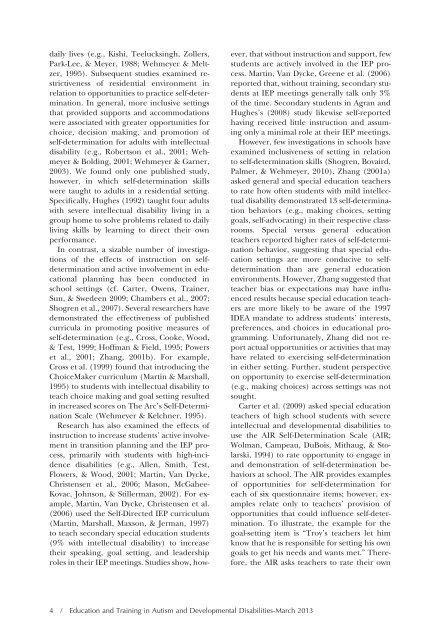etadd_48(1) - Division on Autism and Developmental Disabilities
etadd_48(1) - Division on Autism and Developmental Disabilities
etadd_48(1) - Division on Autism and Developmental Disabilities
You also want an ePaper? Increase the reach of your titles
YUMPU automatically turns print PDFs into web optimized ePapers that Google loves.
daily lives (e.g., Kishi, Teelucksingh, Zollers,<br />
Park-Lee, & Meyer, 1988; Wehmeyer & Meltzer,<br />
1995). Subsequent studies examined restrictiveness<br />
of residential envir<strong>on</strong>ment in<br />
relati<strong>on</strong> to opportunities to practice self-determinati<strong>on</strong>.<br />
In general, more inclusive settings<br />
that provided supports <strong>and</strong> accommodati<strong>on</strong>s<br />
were associated with greater opportunities for<br />
choice, decisi<strong>on</strong> making, <strong>and</strong> promoti<strong>on</strong> of<br />
self-determinati<strong>on</strong> for adults with intellectual<br />
disability (e.g., Roberts<strong>on</strong> et al., 2001; Wehmeyer<br />
& Bolding, 2001; Wehmeyer & Garner,<br />
2003). We found <strong>on</strong>ly <strong>on</strong>e published study,<br />
however, in which self-determinati<strong>on</strong> skills<br />
were taught to adults in a residential setting.<br />
Specifically, Hughes (1992) taught four adults<br />
with severe intellectual disability living in a<br />
group home to solve problems related to daily<br />
living skills by learning to direct their own<br />
performance.<br />
In c<strong>on</strong>trast, a sizable number of investigati<strong>on</strong>s<br />
of the effects of instructi<strong>on</strong> <strong>on</strong> selfdeterminati<strong>on</strong><br />
<strong>and</strong> active involvement in educati<strong>on</strong>al<br />
planning has been c<strong>on</strong>ducted in<br />
school settings (cf. Carter, Owens, Trainer,<br />
Sun, & Swedeen 2009; Chambers et al., 2007;<br />
Shogren et al., 2007). Several researchers have<br />
dem<strong>on</strong>strated the effectiveness of published<br />
curricula in promoting positive measures of<br />
self-determinati<strong>on</strong> (e.g., Cross, Cooke, Wood,<br />
& Test, 1999; Hoffman & Field, 1995; Powers<br />
et al., 2001; Zhang, 2001b). For example,<br />
Cross et al. (1999) found that introducing the<br />
ChoiceMaker curriculum (Martin & Marshall,<br />
1995) to students with intellectual disability to<br />
teach choice making <strong>and</strong> goal setting resulted<br />
in increased scores <strong>on</strong> The Arc’s Self-Determinati<strong>on</strong><br />
Scale (Wehmeyer & Kelchner, 1995).<br />
Research has also examined the effects of<br />
instructi<strong>on</strong> to increase students’ active involvement<br />
in transiti<strong>on</strong> planning <strong>and</strong> the IEP process,<br />
primarily with students with high-incidence<br />
disabilities (e.g., Allen, Smith, Test,<br />
Flowers, & Wood, 2001; Martin, Van Dycke,<br />
Christensen et al., 2006; Mas<strong>on</strong>, McGahee-<br />
Kovac, Johns<strong>on</strong>, & Stillerman, 2002). For example,<br />
Martin, Van Dycke, Christensen et al.<br />
(2006) used the Self-Directed IEP curriculum<br />
(Martin, Marshall, Maxs<strong>on</strong>, & Jerman, 1997)<br />
to teach sec<strong>on</strong>dary special educati<strong>on</strong> students<br />
(9% with intellectual disability) to increase<br />
their speaking, goal setting, <strong>and</strong> leadership<br />
roles in their IEP meetings. Studies show, how-<br />
ever, that without instructi<strong>on</strong> <strong>and</strong> support, few<br />
students are actively involved in the IEP process.<br />
Martin, Van Dycke, Greene et al. (2006)<br />
reported that, without training, sec<strong>on</strong>dary students<br />
at IEP meetings generally talk <strong>on</strong>ly 3%<br />
of the time. Sec<strong>on</strong>dary students in Agran <strong>and</strong><br />
Hughes’s (2008) study likewise self-reported<br />
having received little instructi<strong>on</strong> <strong>and</strong> assuming<br />
<strong>on</strong>ly a minimal role at their IEP meetings.<br />
However, few investigati<strong>on</strong>s in schools have<br />
examined inclusiveness of setting in relati<strong>on</strong><br />
to self-determinati<strong>on</strong> skills (Shogren, Bovaird,<br />
Palmer, & Wehmeyer, 2010). Zhang (2001a)<br />
asked general <strong>and</strong> special educati<strong>on</strong> teachers<br />
to rate how often students with mild intellectual<br />
disability dem<strong>on</strong>strated 13 self-determinati<strong>on</strong><br />
behaviors (e.g., making choices, setting<br />
goals, self-advocating) in their respective classrooms.<br />
Special versus general educati<strong>on</strong><br />
teachers reported higher rates of self-determinati<strong>on</strong><br />
behavior, suggesting that special educati<strong>on</strong><br />
settings are more c<strong>on</strong>ducive to selfdeterminati<strong>on</strong><br />
than are general educati<strong>on</strong><br />
envir<strong>on</strong>ments. However, Zhang suggested that<br />
teacher bias or expectati<strong>on</strong>s may have influenced<br />
results because special educati<strong>on</strong> teachers<br />
are more likely to be aware of the 1997<br />
IDEA m<strong>and</strong>ate to address students’ interests,<br />
preferences, <strong>and</strong> choices in educati<strong>on</strong>al programming.<br />
Unfortunately, Zhang did not report<br />
actual opportunities or activities that may<br />
have related to exercising self-determinati<strong>on</strong><br />
in either setting. Further, student perspective<br />
<strong>on</strong> opportunity to exercise self-determinati<strong>on</strong><br />
(e.g., making choices) across settings was not<br />
sought.<br />
Carter et al. (2009) asked special educati<strong>on</strong><br />
teachers of high school students with severe<br />
intellectual <strong>and</strong> developmental disabilities to<br />
use the AIR Self-Determinati<strong>on</strong> Scale (AIR;<br />
Wolman, Campeau, DuBois, Mithaug, & Stolarski,<br />
1994) to rate opportunity to engage in<br />
<strong>and</strong> dem<strong>on</strong>strati<strong>on</strong> of self-determinati<strong>on</strong> behaviors<br />
at school. The AIR provides examples<br />
of opportunities for self-determinati<strong>on</strong> for<br />
each of six questi<strong>on</strong>naire items; however, examples<br />
relate <strong>on</strong>ly to teachers’ provisi<strong>on</strong> of<br />
opportunities that could influence self-determinati<strong>on</strong>.<br />
To illustrate, the example for the<br />
goal-setting item is “Troy’s teachers let him<br />
know that he is resp<strong>on</strong>sible for setting his own<br />
goals to get his needs <strong>and</strong> wants met.” Therefore,<br />
the AIR asks teachers to rate their own<br />
4 / Educati<strong>on</strong> <strong>and</strong> Training in <strong>Autism</strong> <strong>and</strong> <strong>Developmental</strong> <strong>Disabilities</strong>-March 2013
















